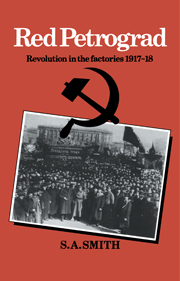Book contents
- Frontmatter
- Contents
- Acknowledgements
- Introduction
- 1 A profile of the Petrograd working class on the eve of 1917
- 2 The tsarist factory
- 3 The February Revolution: A new dispensation in the factories
- 4 The structure and functions of the factory committees
- 5 Trade unions and the betterment of wages
- 6 The theory and practice of workers' control of production
- 7 Deepening economic chaos and the intensification of workers' control
- 8 The social structure of the labour movement
- 9 The October Revolution and the organisation of industry
- 10 The economic crisis and the fate of workers' control: October 1917 to June 1918
- Conclusion
- Notes
- Bibliography
- Index
9 - The October Revolution and the organisation of industry
Published online by Cambridge University Press: 11 January 2010
- Frontmatter
- Contents
- Acknowledgements
- Introduction
- 1 A profile of the Petrograd working class on the eve of 1917
- 2 The tsarist factory
- 3 The February Revolution: A new dispensation in the factories
- 4 The structure and functions of the factory committees
- 5 Trade unions and the betterment of wages
- 6 The theory and practice of workers' control of production
- 7 Deepening economic chaos and the intensification of workers' control
- 8 The social structure of the labour movement
- 9 The October Revolution and the organisation of industry
- 10 The economic crisis and the fate of workers' control: October 1917 to June 1918
- Conclusion
- Notes
- Bibliography
- Index
Summary
THE DEGREE ON WORKERS CONTROL
The Bolshevik seizure of power on 24–5 October was welcomed by a big majority of workers in Petrograd, who had tired of Kerensky's ‘government of swindlers’. The Bolshevik action was seen as inaugurating a revolutionary government by the people, though the precise shape which this government should take was a matter of dispute. For industrial workers, one of the most important of the initial measures passed by the new government was the Decree on Workers' Control, published on 14 November. This Decree legalised the de facto control which had been established in the factories of Petrograd since the February Revolution.
The All-Russian Council of Factory Committees (ARCFC), set up after the First All-Russian Conference, drafted a decree on workers' control, which they discussed with Lenin and representatives from the All-Russian Council of Trade Unions as early as 26 October. Astonishingly, their decree was entirely about the creation of a central apparatus to regulate the economy, i.e. what subsequently was to be established as the Supreme Council of National Economy (VSNKh). It said nothing about workers' control, i.e. about the activities of workers at the grass roots, and for this reason it was criticised by Lenin. He therefore proceeded to draft an alternative decree. This decree breathes a spirit of libertarianism which reflects Lenin's profound faith at this time in the creativity of the masses. It recognised the right of workers in all industrial enterprises of whatever size to control all aspects of production, to have complete access to all spheres of administration, including the financial, and, finally, the right of the lower organs of workers' control to bind employers by their decisions.
- Type
- Chapter
- Information
- Red PetrogradRevolution in the Factories, 1917–1918, pp. 209 - 229Publisher: Cambridge University PressPrint publication year: 1983

